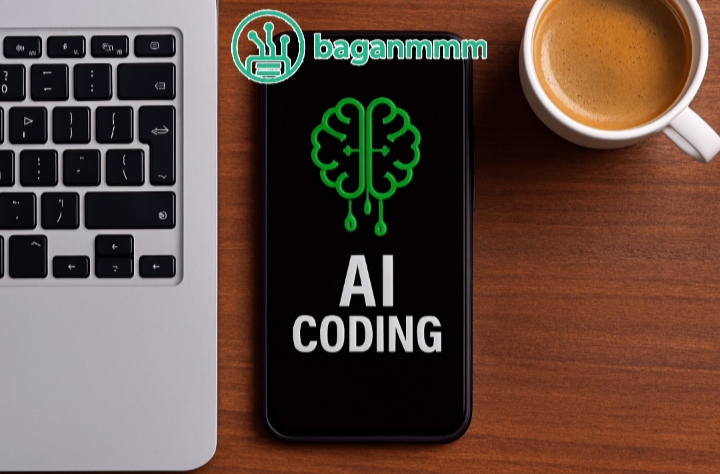Artificial intelligence is no longer just a helpful assistant in programming — it’s a transformative force. From writing code to debugging, testing, and even designing entire applications, AI tools have evolved into intelligent collaborators that accelerate development, reduce errors, and empower developers of all skill levels.

Whether you’re a solo coder, a startup founder, or part of a large engineering team, understanding how AI enhances programming is essential to staying competitive and efficient.
How AI Works in Programming (2025 Deep Dive)
AI in programming is powered by a combination of machine learning algorithms, large language models (LLMs), and natural language processing (NLP). These systems are trained to understand code syntax, logic patterns, and developer intent — enabling them to assist, generate, and even autonomously write software.
Here’s how it works under the hood:
1. Problem Definition
Before any AI model is built, the task must be clearly defined. In programming, this could be:
– Predicting the next line of code
– Generating a function from a prompt
– Detecting bugs or vulnerabilities
– Refactoring legacy code
The model’s objective determines its architecture and training strategy.
2. Data Collection & Preprocessing
AI models are trained on massive datasets — billions of lines of code from open-source repositories, documentation, and forums.
– Data Cleaning: Remove duplicates, fix syntax errors, and normalize formatting.
– Feature Extraction: Identify code structures, dependencies, and semantic patterns.
– Tokenization: Break code into meaningful units (tokens) for model input.
This step ensures the model learns from clean, structured, and diverse examples.
3. Model Selection & Training
Depending on the task, different types of models are used:
| Model Type | Use Case Example |
|---|---|
| Supervised Learning | Used for tasks like code completion, bug prediction, and syntax correction by training on labeled datasets of input-output code pairs. |
| Unsupervised Learning | Applied in code clustering, anomaly detection, and pattern recognition without labeled data, helping discover hidden structures in large codebases. |
| Reinforcement Learning | Used to train autonomous coding agents that learn optimal strategies through trial and error, such as navigating complex logic trees or optimizing build pipelines. |
| Transformer Models | Foundation of modern LLMs like GPT and Claude, used for generating human-like code, documentation, and natural language explanations from prompts. |
Training involves feeding the model code examples and adjusting its parameters using optimization algorithms like gradient descent. The model learns to predict, generate, or classify based on patterns in the data.
4. Evaluation & Tuning
Once trained, the model is tested using validation and test sets:
– Accuracy: How often it predicts correct code
– Precision/Recall: How well it identifies bugs or relevant suggestions
– Loss Metrics: Measures like Mean Squared Error (MSE) or Cross-Entropy Loss
Hyperparameters are tuned using techniques like grid search or Bayesian optimization to improve performance.
5. Deployment & Integration
After training, the model is deployed into real-world environments:
– IDE Plugins: Integrated into tools like VS Code, IntelliJ, or Android Studio
– APIs: Exposed via REST or GraphQL for use in web apps or CI/CD pipelines
– Cloud Services: Hosted on platforms like Azure AI, AWS SageMaker, or Google Vertex AI
Developers interact with these models through prompts, autocomplete, or intelligent suggestions — making AI a seamless part of the coding experience.
6. Continuous Learning
Modern AI systems in programming are updated regularly:
– Feedback loops: User corrections and ratings help retrain the model
– Fine-tuning: Models are adapted to specific domains (e.g., finance, gaming, healthcare)
– Model versioning: Ensures stability and traceability across deployments
This keeps the AI relevant, accurate, and aligned with evolving coding standards.
Key Benefits of AI in Programming
1. Faster Code Generation
AI tools like GitHub Copilot, Gemini CLI, and Tabnine now generate entire functions, classes, or even microservices from natural language prompts. Developers can describe what they want “Create a REST API for user authentication” and the AI builds it with proper syntax, structure, and even documentation.
– Context-aware suggestions: AI understands the surrounding code and adapts its output accordingly.
– Multi-language support: Works across Python, JavaScript, Go, Rust, and more.
– Time savings: Reduces boilerplate coding and accelerates prototyping.
2. Smarter Debugging
AI doesn’t just flag errors it explains them, suggests fixes, and even rewrites faulty logic. It can detect:
– Syntax errors: Missing brackets, typos, or incorrect declarations.
– Logic flaws: Misused conditions, infinite loops, or incorrect return values.
– Security vulnerabilities: SQL injection, XSS, or unsafe dependencies.
Advanced tools now integrate with IDEs to offer real-time debugging assistance, and some even simulate test environments to validate fixes before deployment.
3. Automated Testing
– Unit tests: For individual functions and methods.
– Integration tests: To validate interactions between modules.
– Edge-case scenarios: Based on historical bug patterns and user behavior.
Tools like Testim and CodiumAI use machine learning to predict what needs testing and generate assertions automatically. This improves coverage and reduces manual effort.
4. Code Optimization
AI-powered refactoring tools analyze code for inefficiencies and suggest improvements:
– Algorithm selection: Replacing nested loops with hash maps or optimized sorting.
– Memory usage: Identifying leaks or unnecessary allocations.
– Redundancy removal: Eliminating duplicate logic or unused variables.
These tools help maintain clean, scalable codebases and are especially useful in performance-critical applications like gaming, finance, or real-time systems.
5. Natural Language Programming
Prompt-based development is now mainstream. Developers can write:
And AI will generate the HTML, CSS, JavaScript, and backend logic. This lowers the barrier for non-coders and speeds up MVP development.
– Multimodal input: Some tools accept voice, sketches, or screenshots as prompts.
– Rapid prototyping: Ideal for startups and UX-first workflows.
– Accessibility: Empowers designers, product managers, and educators to contribute directly.
6. Improved Collaboration
– Auto-generating documentation: Summarizing code behavior and usage.
– Standardizing naming conventions: Suggesting consistent variable and function names.
– Code commenting: Explaining logic inline for easier onboarding.
This reduces friction in distributed teams and helps junior developers ramp up faster. AI also assists in code reviews by flagging style violations and suggesting improvements.
Emerging Trends in 2025
– AI in CI/CD Pipelines: Automating deployment, rollback, and performance monitoring
– AI-Generated UI/UX: Creating wireframes and layouts from design prompts
– Multimodal Development: Combining voice, text, and visual inputs to build software
– AI-Driven DevOps: Predicting infrastructure needs and automating scaling decisions
Final Thought
In 2025, AI isn’t replacing developers it’s amplifying them. It’s the silent teammate that never sleeps, never forgets syntax, and always has a suggestion ready. By embracing AI in programming, developers can focus more on creativity, architecture, and solving real-world problems — while letting machines handle the repetitive and technical grunt work.
Alice is the visionary behind Baganmmm Tech, a platform he founded with a passion for demystifying the complex world of technology. As the Lead Technologist, he's often found in his home lab – a cozy, wire-filled sanctuary where ideas are born and code is meticulously crafted. His infectious enthusiasm and knack for explaining intricate concepts make him the go-to expert for everything from web development to emerging tech trends.
